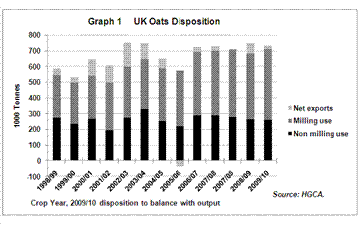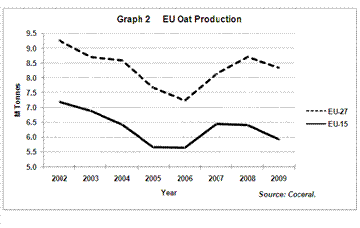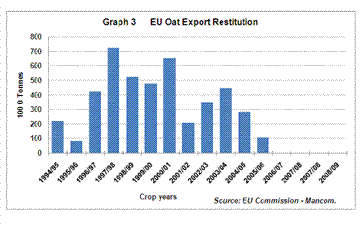
Oat Market Update
- Tuesday November 11, 2009
This analysis featured in the November 11, 2009 issue of the HGCA's MI Prospects, Volume 12, Issue 10
Key Points
Increase in both UK and EU beginning stocks
UK and EU output somewhat lower
Only modest increase in consumption
UK and EU oat markets appeared oversupplied last year, but with smaller crops in 2009 look in better balance this year.
2008/2009 UK Review
UK oat production increased by 10% to 0.78Mt in 2008. This resulted from a third successive increase in area, which was stimulated by relatively favourable prices in autumn 2007. Early harvested oats in 2008 met expectations for exceptionally good yields of very high quality. But the majority of the crop was relatively late maturing and ran into weather challenges in late August and early September. The eventual yield was close to average.
The increase in output was above domestic requirements, putting the UK market on an export basis for milling and usual feeding needs. Defra surveys indicated that milling consumption unexpectedly declined by 2% to 419,000t last year. This follows four years when growth averaged more than 7%. This rather abrupt reversal may have been a result of recessionary economic conditions, although food is generally thought to be less dependent on economic conditions, or perhaps reduced sales of more price sensitive organic foods. But these are a relatively small proportion of even the breakfast cereal market. Monthly usage data indicate the decline occurred in the second half of the season.
As is usually the case, net-exports increased to clear the potential surplus supplies. Exports rose to 85,500t, 20% above 2007/08. Spain was again the largest destination for exports, but cross-channel trade was up as well. Imports declined by more than 70% to 18,900t, probably a reflection of the improved quality of the UK crop. Supply and demand calculations suggest that residual use, mainly livestock feed, was at about 250,000t very similar to the previous two years' level. Surveys indicate an increase of almost 60% in ending stocks in commercial positions to 102,000t. The increase may reflect a perceived need for protection against potential quality shortfalls or simply availability. In any event, good quality oats were in good supply all season.
continue
2009/2010 UK Prospects
Last autumn's wet weather reduced the area sown to oats before the 1 December date of Defra's winter cereal area survey by more than 20% below the 2007 area. Mild weather in February and March, however, allowed for some unconventionally late planting of winter varieties and with favourable very early spring conditions, total oat area was, at 128,600ha, only 5% below the previous year's area.
Provisional Defra estimates place yields down 2% which is generally in line with other cereals. Total output is placed at 0.73Mt, down 7% on 2008. The crop was harvested in good condition over most of southern England. But less favourable weather on later maturing winter crops and spring sown crops were reported for Scotland for a second year. These have resulted in loss of milling quality for a significant proportion of the crop.
Overall quality of the crop may not match that of 2008, but millers have, however, expressed confidence that sufficient crop was taken off early in reasonable condition to meet their quality needs. A further feature of this year's supply situation is the increase in carry-over supplies which are believed to be of milling quality. Total UK supply of oats is 0.83Mt before allowance for imports according to Defra's provisional supply and demand data. This is just 4% below last year's supplies.
An increase in milling demand is generally expected. Annual oat milling consumption has only declined once and that was for a single year. This may be following the recognition of oat's nutritional value in the diet and the rapid expansion in retail oat products about fifteen years ago. If the longer-term growth rate of 7% is applied to last year's surveyed usages, suggested milling consumption would be about 450,000t. Assuming a conventional feed and residual use of about 260,000t, would indicate ending stocks and net-exports of about 120,000t. This compares to 167,000t last season and may therefore seem anything but burdensome.
The European supply situation for oats and all feed grain has, however, changed dramatically from a year ago. Last season almost 60,000t of UK oats were exported to Europe between July - October when feed grain supplies were relatively tight. UK winter oats held a market advantage during this period as they are available before their spring grown Continental and Scandinavian competition. This year's exports for the four-month period are likely to be under 10,000t.
Looking forward, the prospects for sowing oats may be more dependent on prospects for alternative break crops. With malting barley premiums at low levels, the oat area may not decline as much as otherwise expected. By spring, the option may point more directly to spring oats even though harvests have been miserable for the last two years.
EU Oat Situation
Coceral's September estimate of EU-27 2009 oat production was down 4% on 2008 at 8.3Mt. For the EU-15, which contributes to almost all of the oat trade, oat output was down 7% at 5.9Mt. Although the crop is not large in an historic context, it follows a 26% increase in ending stocks and is at a time when other feed grain supplies are abundant. And with consumption levels estimated to remain stable, 2009/10 ending stocks are likely to be at a similar level to last at 1.3Mt.
continue
CAP support for oats was provided through the Scandinavian oat export restitutions which were negotiated by Sweden and Finland when they joined the EU in 1995. This was seen as an alternative to a conventional CAP cereal support regime involving intervention and such. With set-aside, bio-energy and other programmes, the oat area has declined and the structural oat surplus dissipated. Export restitutions were last used in autumn 2005 (Graph 3). Since that time, only the odd cargo of Finnish oats has been exported to the east coast of the US, which had been the major export market for Swedish and Finnish oats. So far there has been no discussion to re-introduce this programme, which would certainly need justification, given the CAP changes since 2005.
continue
David Walker (001) 780 434 7615
top of page